Integration of Sentinel-1A Radar and SMAP Radiometer for Soil Moisture Retrieval over Vegetated Areas
Abstract
1. Introduction
2. Materials and Methods
2.1. Study Area and Data
2.1.1. Study Area
2.1.2. Field Data
2.1.3. Sentinel-1A Level 1 GRD
2.1.4. SMAP L3 Brightness Temperature
2.1.5. VIIRS Land Surface and Vegetation Index Data
2.2. Methods
2.2.1. Spatial Resolution Downscaling
2.2.2. Synergic Approach
3. Results
4. Discussion
5. Conclusions
Author Contributions
Funding
Institutional Review Board Statement
Informed Consent Statement
Data Availability Statement
Conflicts of Interest
Abbreviations
| SMAP | Soil Moisture Active Passive |
| SFIM | Smoothing Filter-based Intensity Modulation |
| ANN | Artificial Neural Network |
| BG | Backus–Gilbert |
| VIIRS | Visible Infrared Imaging Radiometer Suite |
| SAR | Synthetic Aperture Radar |
| IW | Interferometric Wide |
| GRD | Ground Range Detected |
| MODIS | Moderate-resolution Imaging Spectroradiometer |
| AVHRR | Advanced Very-High-Resolution Radiometer |
| SeaWIFS | Sea-viewing Wide Field-of-view Sensor |
| OLS | Operational Linescan System |
| SDRs | Sensor Data Records |
| EDRs | Environmental Data Records |
| LST | Land Surface Temperature |
| VI | Vegetation Index |
| TOA-NDVI | Top of Atmosphere–Normalized Difference Vegetation Index |
| MLP | Multi-Layer Perceptron |
References
- Ellepola, A.V. Evaluating the Relationship Between Vegetation Types and Downscaled Surface Soil Moisture Data. Master’s Thesis, University of Mississippi, Lafayette, MS, USA, 2023. [Google Scholar]
- Kerr, Y.H. Soil Moisture from Space: Where Are We? Hydrogeol. J. 2007, 15, 117–120. [Google Scholar] [CrossRef]
- Peng, J.; Loew, A.; Merlin, O.; Verhoest, N.E.C. A Review of Spatial Downscaling of Satellite Remotely Sensed Soil Moisture: Downscale Satellite-Based Soil Moisture. Rev. Geophys. 2017, 55, 341–366. [Google Scholar] [CrossRef]
- Legates, D.R.; Mahmood, R.; Levia, D.F.; DeLiberty, T.L.; Quiring, S.M.; Houser, C.; Nelson, F.E. Soil Moisture: A Central and Unifying Theme in Physical Geography. Prog. Phys. Geogr. Earth Environ. 2011, 35, 65–86. [Google Scholar] [CrossRef]
- Munoz-Martin, J.F.; Llaveria, D.; Herbert, C.; Pablos, M.; Park, H.; Camps, A. Soil Moisture Estimation Synergy Using GNSS-R and L-Band Microwave Radiometry Data from FSSCat/FMPL-2. Remote Sens. 2021, 13, 994. [Google Scholar] [CrossRef]
- Wei, L.; Zhang, B.; Wang, M. Effects of Antecedent Soil Moisture on Runoff and Soil Erosion in Alley Cropping Systems. Agric. Water Manag. 2007, 94, 54–62. [Google Scholar] [CrossRef]
- Dorigo, W.A.; Gruber, A.; De Jeu, R.A.M.; Wagner, W.; Stacke, T.; Loew, A.; Albergel, C.; Brocca, L.; Chung, D.; Parinussa, R.M.; et al. Evaluation of the ESA CCI Soil Moisture Product Using Ground-Based Observations. Remote Sens. Environ. 2015, 162, 380–395. [Google Scholar] [CrossRef]
- Kolassa, J.; Aires, F.; Polcher, J.; Prigent, C.; Jimenez, C.; Pereira, J.M. Soil Moisture Retrieval from Multi-instrument Observations: Information Content Analysis and Retrieval Methodology. JGR Atmos. 2013, 118, 4847–4859. [Google Scholar] [CrossRef]
- Das, N.N.; Entekhabi, D.; Kim, S.; Yueh, S.; O’Neill, P. Combining SMAP and Sentinel Data for High-Resolution Soil Moisture Product. In Proceedings of the 2016 IEEE International Geoscience and Remote Sensing Symposium (IGARSS), Beijing, China, 10–15 July 2016; pp. 129–131. [Google Scholar]
- Lievens, H.; Reichle, R.H.; Liu, Q.; De Lannoy, G.J.M.; Dunbar, R.S.; Kim, S.B.; Das, N.N.; Cosh, M.; Walker, J.P.; Wagner, W. Joint Sentinel-1 and SMAP Data Assimilation to Improve Soil Moisture Estimates. Geophys. Res. Lett. 2017, 44, 6145–6153. [Google Scholar] [CrossRef] [PubMed]
- Mascaro, G.; Vivoni, E.R.; Deidda, R. Downscaling Soil Moisture in the Southern Great Plains through a Calibrated Multifractal Model for Land Surface Modeling Applications. Water Resour. Res. 2010, 46, 2009WR008855. [Google Scholar] [CrossRef]
- Das, N.N.; Entekhabi, D.; Njoku, E.G.; Shi, J.J.C.; Johnson, J.T.; Colliander, A. Tests of the SMAP Combined Radar and Radiometer Algorithm Using Airborne Field Campaign Observations and Simulated Data. IEEE Trans. Geosci. Remote Sens. 2014, 52, 2018–2028. [Google Scholar] [CrossRef]
- Entekhabi, D.; Njoku, E.G.; O’Neill, P.E.; Kellogg, K.H.; Crow, W.T.; Edelstein, W.N.; Entin, J.K.; Goodman, S.D.; Jackson, T.J.; Johnson, J.; et al. The Soil Moisture Active Passive (SMAP) Mission. Proc. IEEE 2010, 98, 704–716. [Google Scholar] [CrossRef]
- Prakash, R.; Singh, D.; Pathak, N.P. A Fusion Approach to Retrieve Soil Moisture with SAR and Optical Data. IEEE J. Sel. Top. Appl. Earth Obs. Remote Sens. 2012, 5, 196–206. [Google Scholar] [CrossRef]
- Carlson, T.N.; Gillies, R.R.; Perry, E.M. A Method to Make Use of Thermal Infrared Temperature and NDVI Measurements to Infer Surface Soil Water Content and Fractional Vegetation Cover. Remote Sens. Rev. 1994, 9, 161–173. [Google Scholar] [CrossRef]
- Ghaffari, Z.; Easson, G.; Yarbrough, L.D.; Awawdeh, A.R.; Jahan, M.N.; Ellepola, A. Using Downscaled GRACE Mascon Data to Assess Total Water Storage in Mississippi Alluvial Plain Aquifer. Sensors 2023, 23, 6428. [Google Scholar] [CrossRef] [PubMed]
- Tang, Q.; Feng, G.; Fisher, D.; Zhang, H.; Ouyang, Y.; Adeli, A.; Jenkins, J. Rain Water Deficit and Irrigation Demand of Major Row Crops in the Mississippi Delta. Trans. ASABE 2018, 61, 927–935. [Google Scholar] [CrossRef]
- Arab, S.; Easson, G.L. Improving Soil Moisture Retrieval Accuracy of Advanced Microwave Scanning Radiometer 2 in Vegetated Areas Using Land Surface Parameters of Visible Infrared Imaging Radiometer Suite. J. Appl. Rem. Sens. 2019, 13, 044520. [Google Scholar] [CrossRef]
- WaterScout SM100 Soil Moisture Sensor Product Manual (Item # 6460); Spectrum Technologies, Inc.: Plainfield, IL, USA.
- ASTM D 2216-98; Standard Test Method for Laboratory Determination of Water (Moisture) Content of Soil and Rock by Mass. ASTM International: West Conshohocken, PA, USA, 1999.
- ASF DAAC. Copernicus Sentinel Data 2016. Available online: https://asf.alaska.edu/ (accessed on 10 October 2016).
- SMAP Mission Team. SMAP Handbook: Soil Moisture Active Passive; National Aeronautics and Space Administration: Washington, DC, USA, 2014.
- Brodzik, M.J.; Billingsley, B.; Haran, T.; Raup, B.; Savoie, M.H. EASE-Grid 2.0: Incremental but Significant Improvements for Earth-Gridded Data Sets. ISPRS Int. J. Geo-Inf. 2012, 1, 32–45. [Google Scholar] [CrossRef]
- Brown, J.P.; Long, D.G. Resolution Enhancement of SMAP Passive Soil Moisture Estimates. Remote Sens. 2022, 14, 1761. [Google Scholar] [CrossRef]
- ONeill, P.E.; Chan, S.; Njoku, E.G.; Jackson, T. SMAP Enhanced L3 Radiometer Global Daily 9 km EASE-Grid Soil Moisture; Version 1; National Snow and Ice Data Center: Boulder, CO, USA, 2016. [Google Scholar]
- Seaman, C.; Hillger, D.W.; Kopp, T.; Williams, R.; Miller, S.; Lindsey, D. Visible Infrared Imaging Radiometer Suite (VIIRS) Imagery Environmental Data Record (EDR) User’s Guide; Version 1.3; National Aeronautics and Space Administration: Washington, DC, USA, 2015. [CrossRef]
- NOAA CLASS Data. JPSS Visible Infrared Imaging Radiometer Suite Environmental Data Record (VIIRS_EDR). Available online: https://www.aev.class.noaa.gov/saa/products/welcome (accessed on 10 October 2016).
- Liu, J.G. Smoothing Filter-Based Intensity Modulation: A Spectral Preserve Image Fusion Technique for Improving Spatial Details. Int. J. Remote Sens. 2000, 21, 3461–3472. [Google Scholar] [CrossRef]
- Liu, J.G.; Mason, P.J. Image Processing and GIS for Remote Sensing: Techniques and Applications; John Wiley & Sons: Hoboken, NJ, USA, 2016. [Google Scholar]
- Chandan, K. Artificial Neural Network Approach for Reservoir Stage Prediction. Chin. J. Math. Sci. 2021, 1. [Google Scholar]
- Zanganeh, M.; Mirabedini, S.J. Comparing Imperialist Competitive Algorithm with Backpropagation Algorithms for Training Feedforward Neural Network. J. Math. Comput. Sci. 2015, 14, 193–204. [Google Scholar] [CrossRef][Green Version]
- Kasabov, N.K. Foundations of Neural Networks, Fuzzy Systems, and Knowledge Engineering; MIT Press: Cambridge, MS, USA, 1996. [Google Scholar]
- Tong, C.; Wang, H.; Magagi, R.; Goïta, K.; Zhu, L.; Yang, M.; Deng, J. Soil Moisture Retrievals by Combining Passive Microwave and Optical Data. Remote Sens. 2020, 12, 3173. [Google Scholar] [CrossRef]
- Abdelkader, M.; Temimi, M.; Colliander, A.; Cosh, M.H.; Kelly, V.R.; Lakhankar, T.; Fares, A. Assessing the Spatiotemporal Variability of SMAP Soil Moisture Accuracy in a Deciduous Forest Region. Remote Sens. 2022, 14, 3329. [Google Scholar] [CrossRef]
- Abbaszadeh, P.; Moradkhani, H.; Zhan, X. Downscaling SMAP Radiometer Soil Moisture Over the CONUS Using an Ensemble Learning Method. Water Resour. Res. 2019, 55, 324–344. [Google Scholar] [CrossRef]
- Ma, C.; Li, X.; Wei, L.; Wang, W. Multi-Scale Validation of SMAP Soil Moisture Products over Cold and Arid Regions in Northwestern China Using Distributed Ground Observation Data. Remote Sens. 2017, 9, 327. [Google Scholar] [CrossRef]
- Njoku, E.G.; Jackson, T.J.; Lakshmi, V.; Chan, T.K.; Nghiem, S.V. Soil Moisture Retrieval from AMSR-E. IEEE Trans. Geosci. Remote Sens. 2003, 41, 215–229. [Google Scholar] [CrossRef]
- Notarnicola, C.; Angiulli, M.; Posa, F. Use of Radar and Optical Remotely Sensed Data for Soil Moisture Retrieval over Vegetated Areas. IEEE Trans. Geosci. Remote Sens. 2006, 44, 925–935. [Google Scholar] [CrossRef]
- Sun, Y.; Huang, S.; Ma, J.; Li, J.; Li, X.; Wang, H.; Chen, S.; Zang, W. Preliminary Evaluation of the SMAP Radiometer Soil Moisture Product over China Using In Situ Data. Remote Sens. 2017, 9, 292. [Google Scholar] [CrossRef]
- Mohseni, F.; Mirmazloumi, S.M.; Mokhtarzade, M.; Jamali, S.; Homayouni, S. Global Evaluation of SMAP/Sentinel-1 Soil Moisture Products. Remote Sens. 2022, 14, 4624. [Google Scholar] [CrossRef]
- Singh, G.; Das, N.; Panda, R.; Mohanty, B.; Entekhabi, D.; Bhattacharya, B. Soil Moisture Retrieval Using SMAP L-Band Radiometer and RISAT-1 C-Band SAR Data in the Paddy Dominated Tropical Region of India. IEEE J. Sel. Top. Appl. Earth Obs. Remote Sens. 2021, 14, 10644–10664. [Google Scholar] [CrossRef]
- Karami, A.; Moradi, H.R.; Mousivand, A.J. Improving spatial resolution of SMAP surface soil moisture through the synergy of radar-microwave observations at the Firoozabad watershed, Ardabil. Watershed Manag. Res. J. 2020, 1399, 17–29. [Google Scholar] [CrossRef]
- He, L.; Hong, Y.; Wu, X.; Ye, N.; Walker, J.P.; Chen, X. Investigation of SMAP Active–Passive Downscaling Algorithms Using Combined Sentinel-1 SAR and SMAP Radiometer Data. IEEE Trans. Geosci. Remote Sens. 2018, 56, 4906–4918. [Google Scholar] [CrossRef]
- Chaubell, J.; Chan, S.; Dunbar, R.; Entekhabi, D.; Peng, J.; Piepmeier, J.; Yueh, S. Backus-Gilbert Optimal Interpoaltion Applied to Enhance SMAP Data: Implementation and Assessment. In Proceedings of the 2017 IEEE International Geoscience and Remote Sensing Symposium (IGARSS), Fort Worth, TX, USA, 23–28 July 2017; pp. 2531–2534. [Google Scholar]

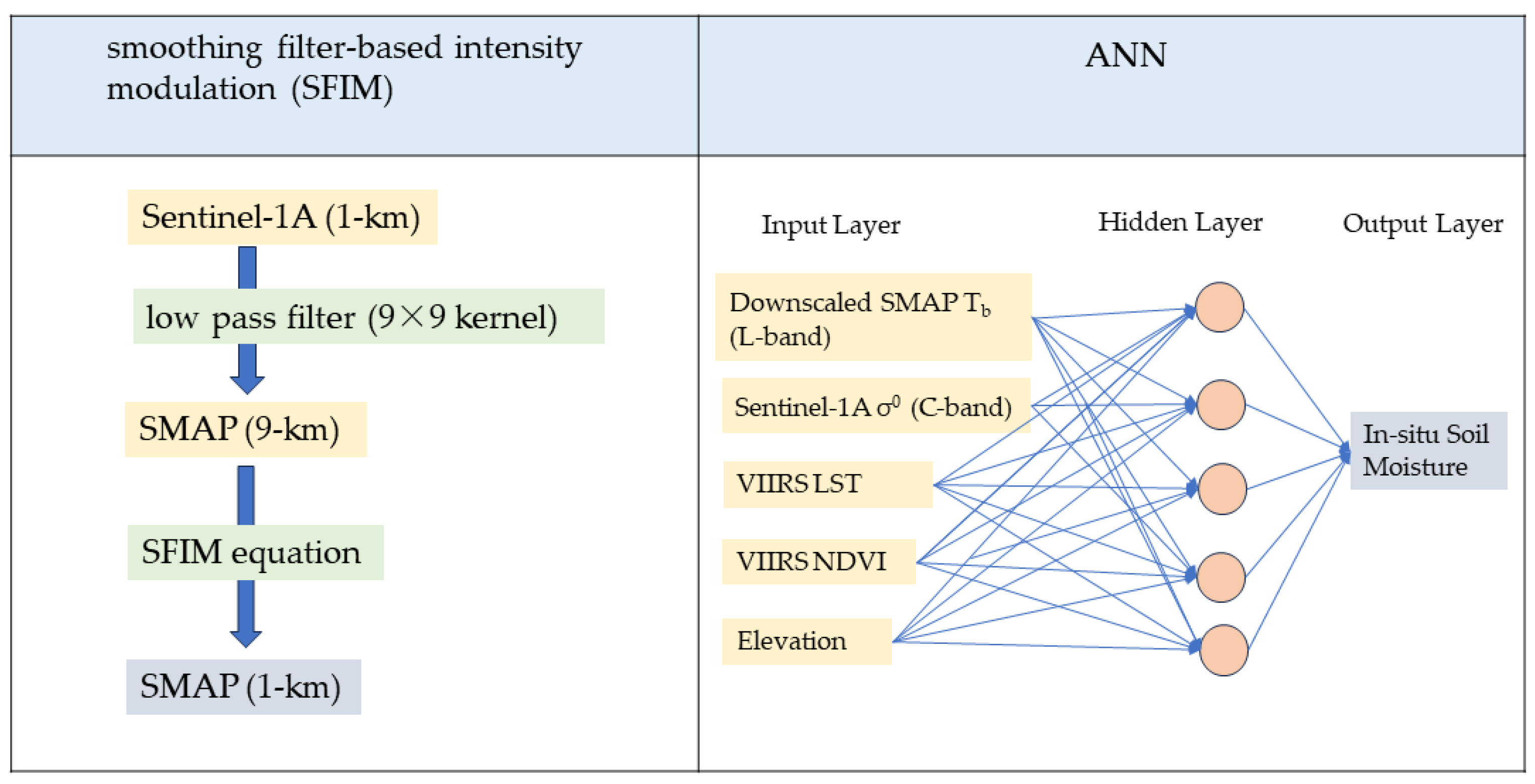
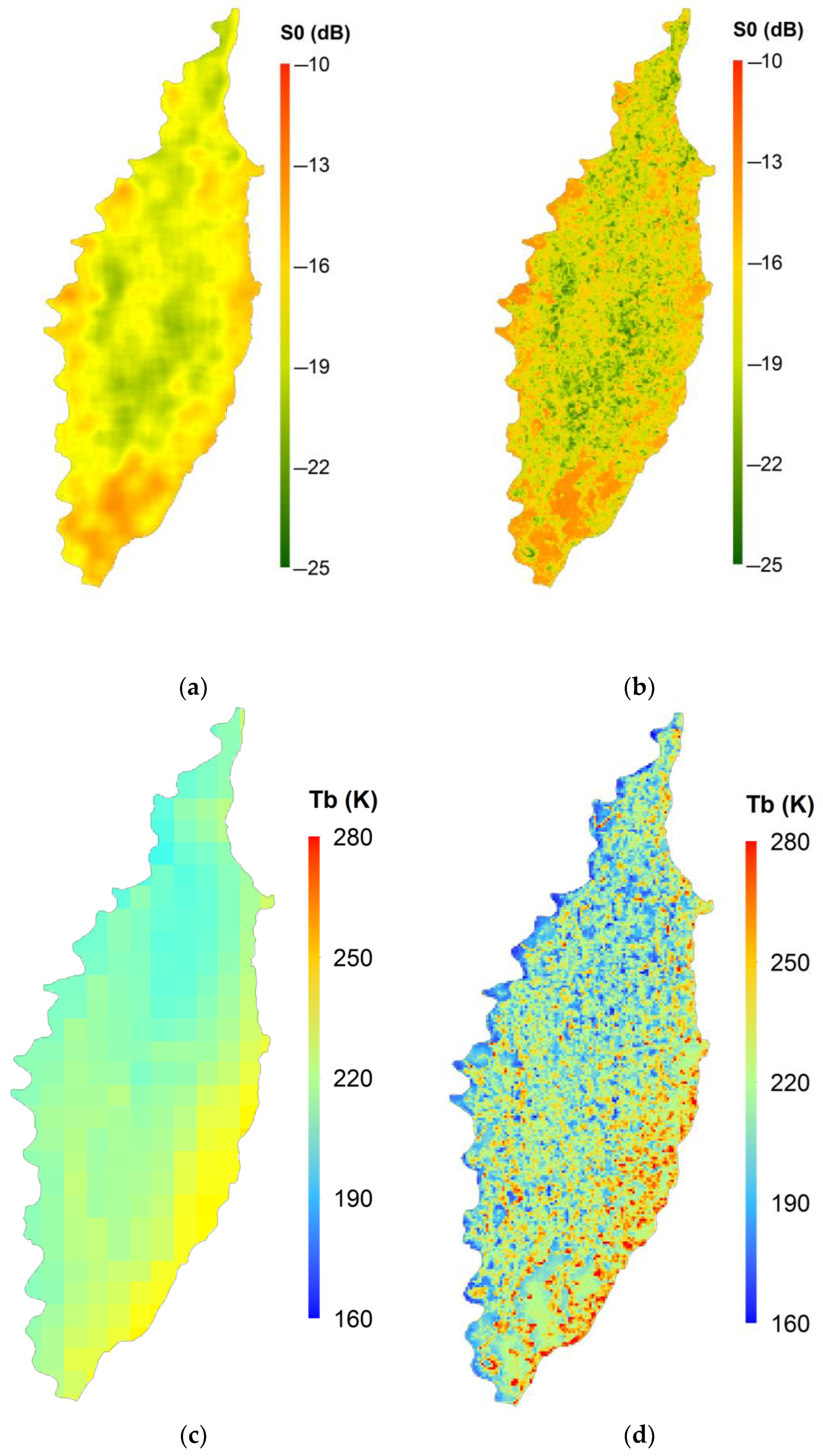


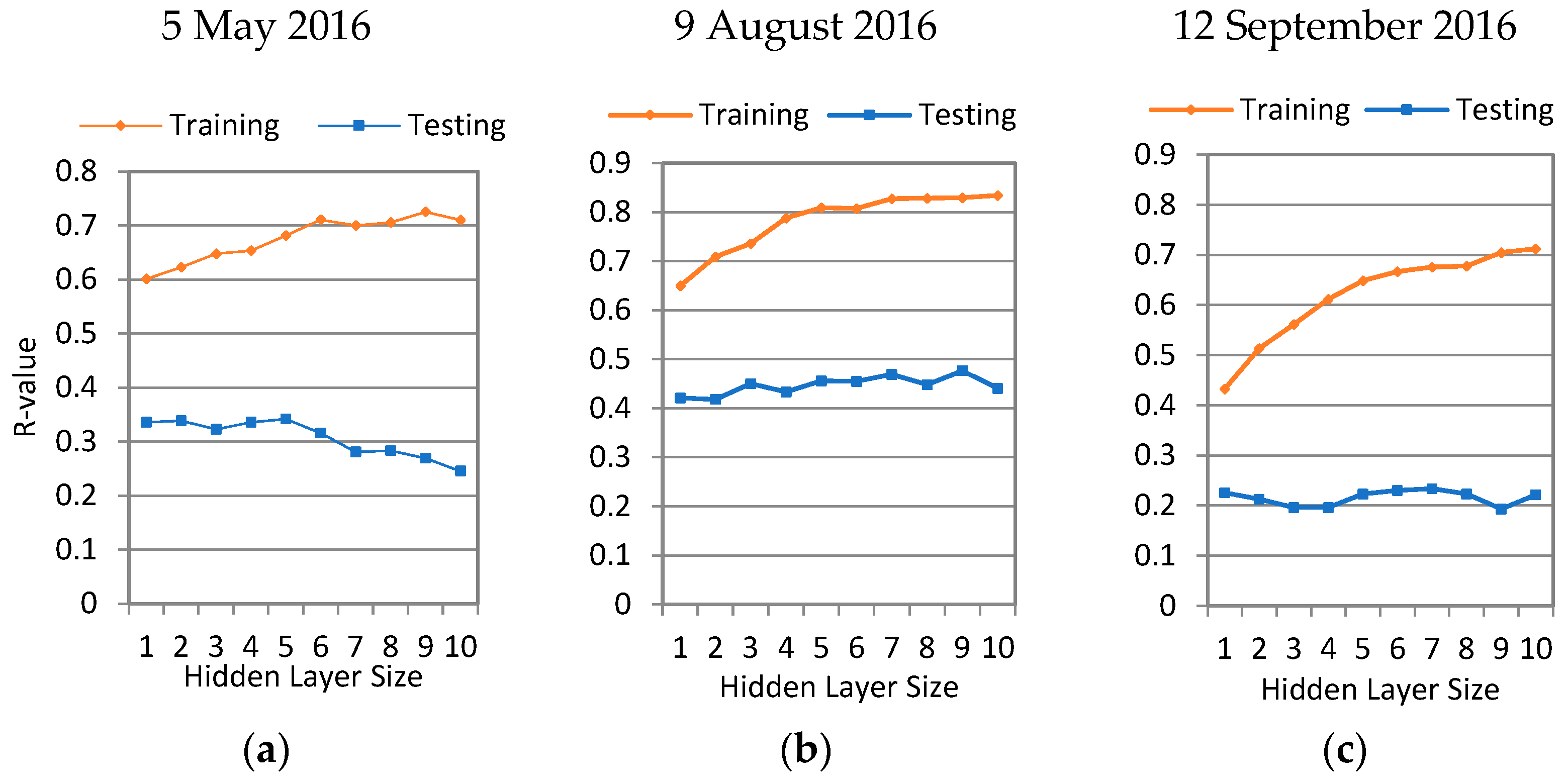
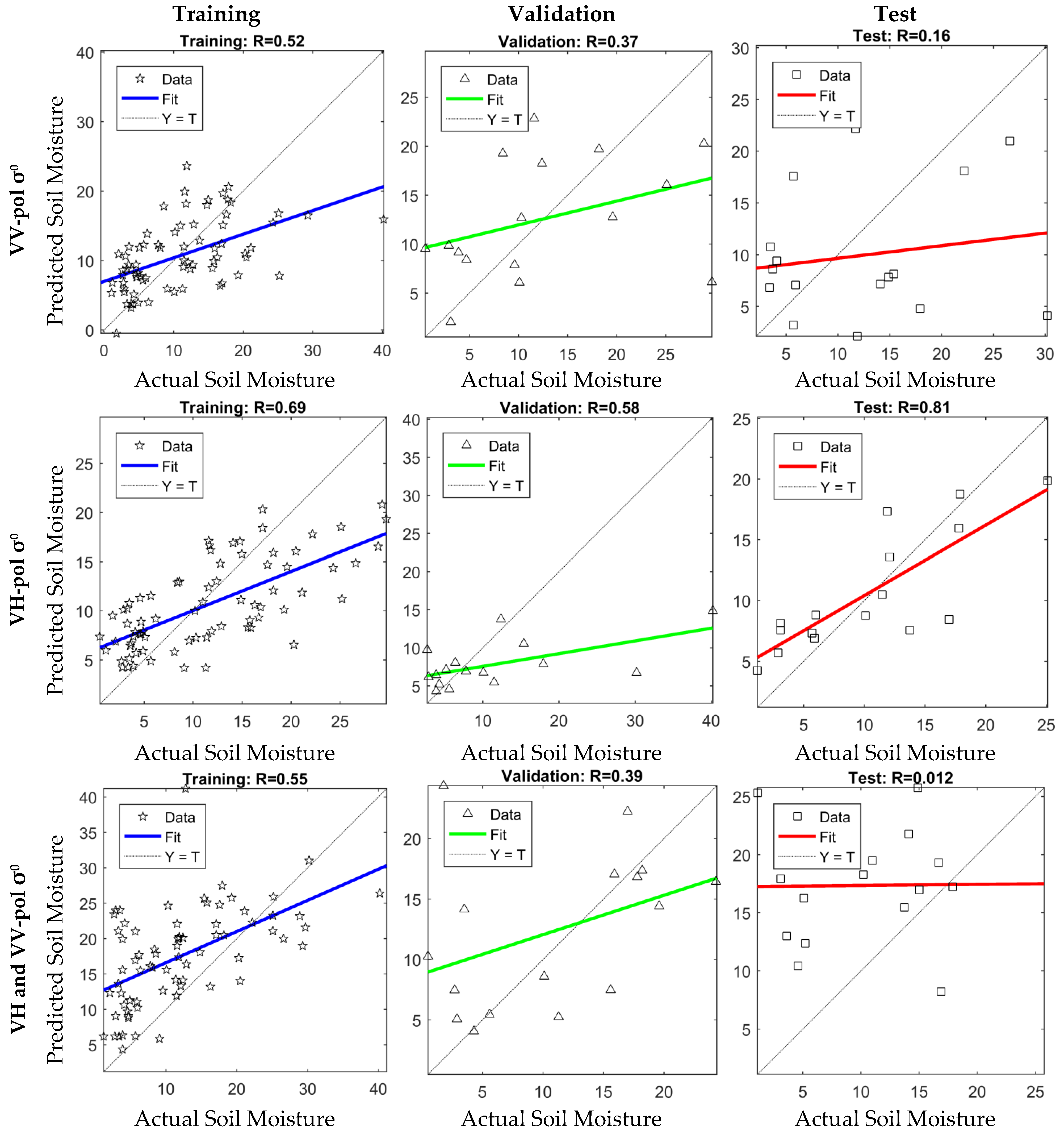
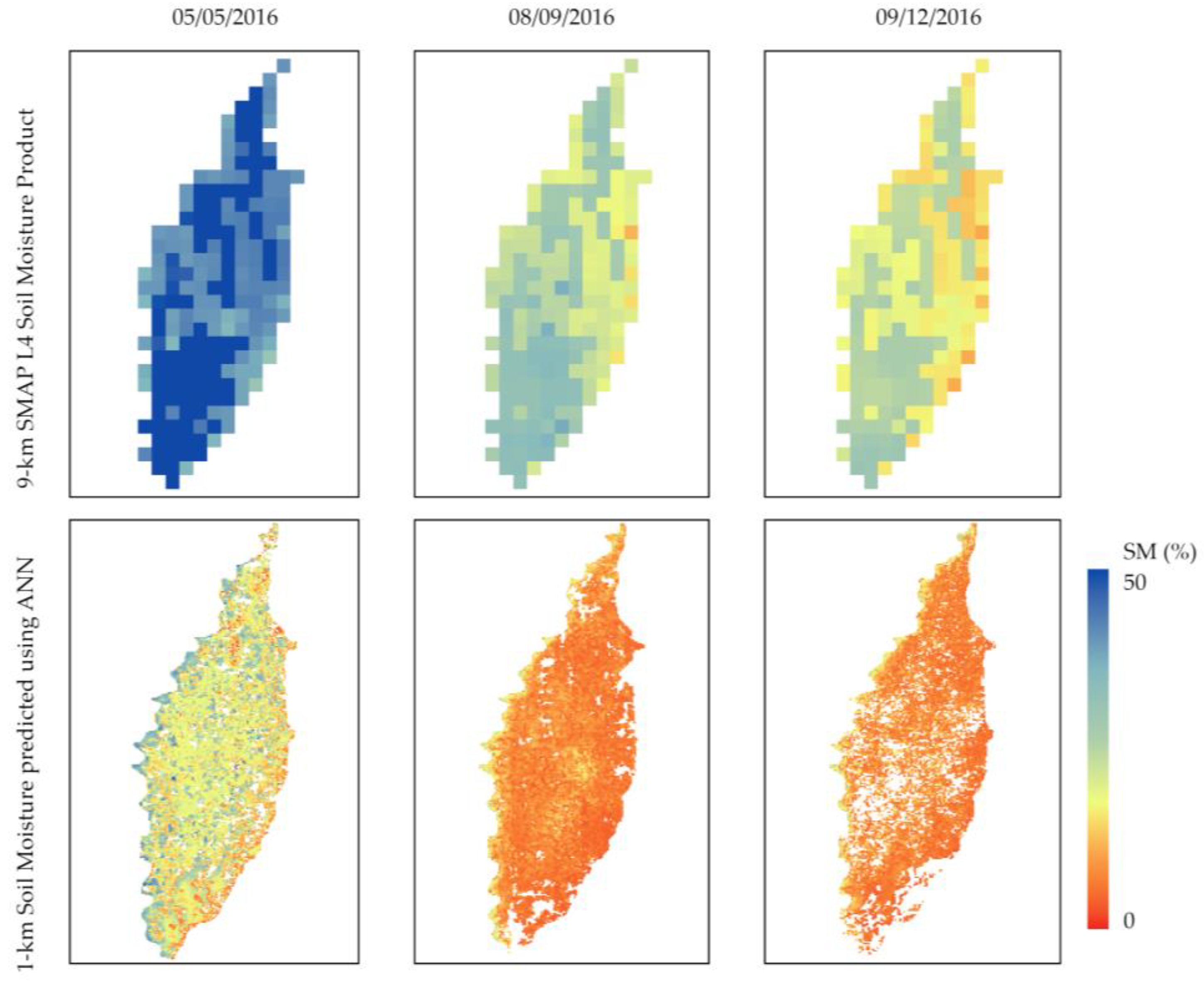
| Input Layer | Output Layer | Testing Results | |
|---|---|---|---|
| Root Mean Squared Error (m3/m3) | Regression R-Value | ||
| NDVI (VIIRS) | Soil Moisture | 3.97 | 0.81 |
| LST (VIIRS) | |||
| H-Pol Brightness Temperature (SMAP) | |||
| VH-pol Backscatter Coefficient (Sentinel-1A) | |||
| NDVI (VIIRS) | Soil Moisture | 10.56 | 0.012 |
| LST (VIIRS) | |||
| H-Pol Brightness Temperature (SMAP) | |||
| VV-Pol Backscatter Coefficient (Sentinel-1A) | |||
| NDVI (VIIRS) | Soil Moisture | 9.75 | 0.16 |
| LST (VIIRS) | |||
| H-Pol Brightness Temperature (SMAP) | |||
| VH-pol Backscatter Coefficient (Sentinel-1A) | |||
| VV-pol Backscatter Coefficient (Sentinel-1A) | |||
Disclaimer/Publisher’s Note: The statements, opinions and data contained in all publications are solely those of the individual author(s) and contributor(s) and not of MDPI and/or the editor(s). MDPI and/or the editor(s) disclaim responsibility for any injury to people or property resulting from any ideas, methods, instructions or products referred to in the content. |
© 2024 by the authors. Licensee MDPI, Basel, Switzerland. This article is an open access article distributed under the terms and conditions of the Creative Commons Attribution (CC BY) license (https://creativecommons.org/licenses/by/4.0/).
Share and Cite
Arab, S.; Easson, G.; Ghaffari, Z. Integration of Sentinel-1A Radar and SMAP Radiometer for Soil Moisture Retrieval over Vegetated Areas. Sensors 2024, 24, 2217. https://doi.org/10.3390/s24072217
Arab S, Easson G, Ghaffari Z. Integration of Sentinel-1A Radar and SMAP Radiometer for Soil Moisture Retrieval over Vegetated Areas. Sensors. 2024; 24(7):2217. https://doi.org/10.3390/s24072217
Chicago/Turabian StyleArab, Saeed, Greg Easson, and Zahra Ghaffari. 2024. "Integration of Sentinel-1A Radar and SMAP Radiometer for Soil Moisture Retrieval over Vegetated Areas" Sensors 24, no. 7: 2217. https://doi.org/10.3390/s24072217
APA StyleArab, S., Easson, G., & Ghaffari, Z. (2024). Integration of Sentinel-1A Radar and SMAP Radiometer for Soil Moisture Retrieval over Vegetated Areas. Sensors, 24(7), 2217. https://doi.org/10.3390/s24072217





